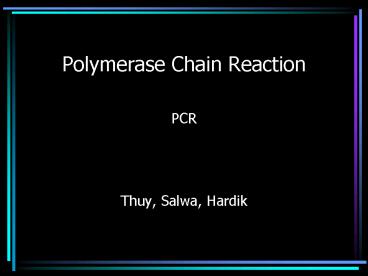Polymerase Chain Reaction - PowerPoint PPT Presentation
1 / 13
Title:
Polymerase Chain Reaction
Description:
He was recognized and was awarded the Nobel Prize in 1994. ... Ligation. Replication. Detection. http://www.juliantrubin.com/encyclopedia/biochemistry/pcr.html ... – PowerPoint PPT presentation
Number of Views:1426
Avg rating:3.0/5.0
Title: Polymerase Chain Reaction
1
Polymerase Chain Reaction
- PCR
- Thuy, Salwa, Hardik
2
PCR
- PCR was invented by Dr. Kary Mullis in 1984. He
was recognized and was awarded the Nobel Prize in
1994. - PCR allows for amplification of a small piece of
DNA. - PCR has become a popular alternative approach to
cloning experiments. - Some other applications of PCR are in forensics
paternity/kinship testing, and the identification
of human remains.
3
PCR
- PCR requires a thermostable DNA polymerase
- The most common type of DNA polymerase is Taq
polymerase - It is obtained from the bacterium Thermus
aquaticus which are found in hot springs - Because the Taq polymerase is thermostable, it
remains stable at near boiling temperatures - 2 Oligonucleotides called primers are also
included in the PCR reaction - 4 deoxynucleotides- The subunits of DNA that are
incorporated into the new DNA copies
4
PCR machine
- The PCR mixture which contains DNA polymerase,
buffer, deoxynucleotides, primers, and template,
go through a cycle of varied temperatures - 3 steps in a cycle
- -Denature
- -Anneal
- -Extend
5
Steps in PCR
- Denature
- -Temperature is raised to near boiling (92ºC)
- -Template DNA is separated into two strands
- Anneal
- -Temperature is lowered (50º-65ºC)
- -Allows the left and right primers to base pair
to their complementary sequences - -Primers purpose is to bracket the DNA region to
be amplified
6
Steps in PCR
- Extend
- -Temperature is raised to 72ºC
- -Taq polymerase attaches at each priming site
- -Uses the nucleotides from the reaction mixture
and attaches it to the growing strand these
nucleotides are complementary to the target
sequence - -Nucleotides called dNTPs A, T, C or G
- dATP, dTTP, dCTP or dGTP
7
(No Transcript)
8
PCR Results
- These 3 steps of PCR result in exponential growth
N 2t (No) of the DNA template in the mixture - Its typically repeated for 20-40 cycles
- But the product amount reaches a maximum after
about 40 cycles due to depletion of the reaction
components
9
PCR- Problems
- Polymerase Errors
- Taq polymerase lacks 3 5 exonulcease activity
- Unwanted amplification of products
- -Contamination
- -Nonspecific primer annealing
10
Applications of PCR
- After PCR the amplified products undergoes
various experiments depending on the objective - DNA fingerprinting used in forensics
- Paternity testing
11
Application of PCR
- Identifying the dead
- - DNA analysis of 1000s of years DNA sample
- Gel electrophoresis
- Cloning experiments
12
Cloning
- The amplified DNA is introduced into a plasmid
vector - Ligation
- Replication
- Detection
13
- http//www.juliantrubin.com/encyclopedia/biochemis
try/pcr.html - http//www.thetech.org/genetics/images/ask/paterni
tyTestFig3.gif































